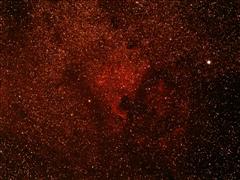 Last night as I sat in my backyard, capturing images of a bright Moon, I thought I caught a human shape in the corner of my eye behind the glare of my laptop’s monitor. Thinking it was one of my neighbors coming by the fence to ask about my astronomical target, I looked up. No one. Perhaps it was the cat. She almost always entertains me when I have my scope out at night by darting around the yard like a black flash.
Last night as I sat in my backyard, capturing images of a bright Moon, I thought I caught a human shape in the corner of my eye behind the glare of my laptop’s monitor. Thinking it was one of my neighbors coming by the fence to ask about my astronomical target, I looked up. No one. Perhaps it was the cat. She almost always entertains me when I have my scope out at night by darting around the yard like a black flash.
Turning back to my work, oh my God, a face was staring at me! My heart pounded, my ears rang like sirens, and I froze stiff in spiraling fear as I realized quickly that this was no friend whose dark eyes peered at me. I thought—then quickly dismissed the idea—that someone was playing with me. This is how it feels to be murdered. The hope drains out of you as you come to grasp that the unthinkable is materializing right before your eyes.
During that brief instant, signals from an unknown part of my brain raced down my spine to the large muscles in my legs. I jumped up out of my chair, feeling like I had been catapulted several feet back. “What the ____ are you doing!?” My eyes were locked on the face, now morphing into the form of a darkly dressed man. He stepped back, as if startled. Not more than eight or ten feet apart, we locked our stares on each other. His gaze, however, had the quality of a predator. He did not answer; he growled. At least that’s the best description I can come up with for the guttural sound that emanated from him. I’ve heard the sound from hunting dogs, wolves and even a cougar. It was surreal, to say the least.
Then, he showed his teeth—large canines. Once again my mind jolted, trying to construct the incredulous picture before me. “OK, what is this?” Somebody’s really playing with me with this vampire act. But, by now there would be laughter as the practical joke had reached its zenith. No laughter. Only the growl and the predatory eyes. I was caught between the yard and the back door of my house. I instinctively moved behind the table which was sitting next to my scope. The bluish light from my laptop glowed, but its eerie light reveal nothing on the table that was of weapon status. That’s when the scene really went crazy.
“Go on, git, you demon!! Git on outta here in the name of Jesus!” I roared with a hoarse voice. Where that came from, I have no idea, almost laughing. It’s the kind of half-silly, half-frightened way I might shoo off a stray dog from the yard. But, at least I was on the offensive now, playing out some kind of unconscious script from a childhood-era horror film.
“Do you honestly believe that you can banish me away with that religious talk?” he laughed. This guy sounds like he’s for real! And, he is advancing in my direction like he means business. For some reason I was wishing I still had that Soul Winner’s New Testament that I got in Mrs. Turner’s Sunday School class. I’d throw it at him. I even said so. “If I had a copy of the Good Book, I’d whoop your butt with it, I snarled.” This is heating up.
“I’ve got your book right here,” he said, as he opened up his jacket and pulled out a little tattered book with gold lettering on the front . . . and a cross on the spine glittering in the moonlight, and it looked a lot like the Soul Winner’s New Testament that I remembered Mrs. Turner putting in my hand when I graduated from Junior I Sunday School and went into the Junior II class with the fifth graders. “Who are you? Screwtape?” I chuckled. It quickly became apparent that the joke was on me. He was walking toward me, closer and closer, holding that book like a dagger and saying “It’s not doing you much good now, is it?”
By now I had ascertained that there was absolutely nothing on the table or under my telescope mount that could serve as a weapon. I thought—and quickly abandoned the thought—of pitching a barlow lens at him. That’s how puny my arsenal was. I had to come up with a different kind of weapon.
“There is more power in that one little book than you know,” I warned, trying to sound stern. “I dare you to read one page!”
“A page for a page!” he stated, with an immediacy and clarity of voice that took me back. I tilted my head, puzzled. “You read a page of this,” pulling another old book from his jacket, “and I’ll read a page of that” nodding toward the tiny New Testament. “Read what?” I asked, wondering what the heck he was talking about. He opened up the old book, and sliced the first page at the binding with his fingernail, folded it into a paper airplane with that one hand and sailed it at me. I grabbed it just as it hit me dead in the chest and flipped on my red LED head lamp to examine it. It was the title page of Darwin’s The Origin of Species. It was even autographed by the old man himself. One after another he sliced out a page and threw it at me, forming a missile with each page, all in one deft stroke.
“But, I believe this stuff, too!” I shouted in a tone that sounded far too defensive, now that I think about it. Did he think I’d be undone by the Theory of Evolution? Did I look like a gullible William Jennings Bryan at the Scopes Monkey Trial (he is, by the way, an ancestor of mine, though I didn’t mention it)? Did he think I’d just stand there while he systematically destroyed a valuable historic document?
Without one iota of forethought, but with a strange mixture of abandonment and fury, I grabbed the 5 milliwatt, 532 nanometer green laser pointer from my shirt pocket and fired it at him. He screamed bloody murder and twisted around with his arm up to shield his face. This thing is really hurting him! I could even smell the odor of burnt flesh as I continued aiming for exposed skin. He shrieked and howled, running wildly . . . away. It was all over in an instant. There I was, still swinging my laser like a sword, shaking.
April 1, 2010
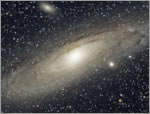 Astronomy podcasts and audio books are a standard part of my commute diet. I can get in about an hour of listening a day on my way to and from work. It’s a great way to stay up-to-date with the latest astrophysical news or to broaden my knowledge of astronomy in general. Check out my links page for some of my favorites. You can also browse iTunes for an extensive list of podcast offerings.
Astronomy podcasts and audio books are a standard part of my commute diet. I can get in about an hour of listening a day on my way to and from work. It’s a great way to stay up-to-date with the latest astrophysical news or to broaden my knowledge of astronomy in general. Check out my links page for some of my favorites. You can also browse iTunes for an extensive list of podcast offerings.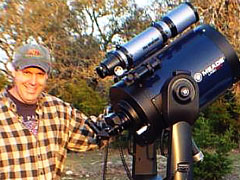 One of my favorite astronomy publications is not a magazine, it is a catalog that Orion Telescopes sends me every month or so. Orion sells a wide assortment of telescopes and accessories and continues to enlarge its offerings with higher-end products. Their prices are quite reasonable, partly due to foreign manufacturing. Historically, a number of companies, including Orion have sold refractors made by Synta Technology Corporation, a manufacturer based in Taiwan. My 80mm ED apochromatic refractor is a Synta product sold under the Skywatcher brand. It is identical to the model that Orion sells, so the accessories that Orion sells for it fit just fine. It is a sweet scope. While many owners of this model have complained of collimation problems, mine is spot on and required none of the DIY customizations that are well-documented on the internet. The optics are very good and I use it almost exclusively for astrophotography.
One of my favorite astronomy publications is not a magazine, it is a catalog that Orion Telescopes sends me every month or so. Orion sells a wide assortment of telescopes and accessories and continues to enlarge its offerings with higher-end products. Their prices are quite reasonable, partly due to foreign manufacturing. Historically, a number of companies, including Orion have sold refractors made by Synta Technology Corporation, a manufacturer based in Taiwan. My 80mm ED apochromatic refractor is a Synta product sold under the Skywatcher brand. It is identical to the model that Orion sells, so the accessories that Orion sells for it fit just fine. It is a sweet scope. While many owners of this model have complained of collimation problems, mine is spot on and required none of the DIY customizations that are well-documented on the internet. The optics are very good and I use it almost exclusively for astrophotography. Last night as I sat in my backyard, capturing images of a bright Moon, I thought I caught a human shape in the corner of my eye behind the glare of my laptop’s monitor. Thinking it was one of my neighbors coming by the fence to ask about my astronomical target, I looked up. No one. Perhaps it was the cat. She almost always entertains me when I have my scope out at night by darting around the yard like a black flash.
Last night as I sat in my backyard, capturing images of a bright Moon, I thought I caught a human shape in the corner of my eye behind the glare of my laptop’s monitor. Thinking it was one of my neighbors coming by the fence to ask about my astronomical target, I looked up. No one. Perhaps it was the cat. She almost always entertains me when I have my scope out at night by darting around the yard like a black flash.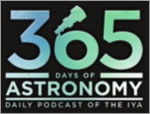 After listening to the International Year of Astronomy Podcasts for a year, I found myself saying to myself one more time: I should do one of these. OK, so I did. The organizers had decided to extend the project for another year and that would give me some time to put some ideas together. I was thinking about something like a talk on my reflections on my experience with astronomy and some of the deeper meanings that a contemplative astronomical experience might bring. Then I took a gander at the calendar for the upcoming year to see how many slots were open. To my surprise, there were not that many days that had not been reserved. So, I quickly shot off an email to Nancy Atkinson at 365daysofastronomy.org and gave her a hastily assembled proposal, hoping I wasn’t too late. She responded the next day with a welcoming tone, assuring me that there were still slots available and that they really needed some podcasts for dates early in the year that hadn’t been claimed, yet. Uh oh, now what do I do? They actually expect me to do this!
After listening to the International Year of Astronomy Podcasts for a year, I found myself saying to myself one more time: I should do one of these. OK, so I did. The organizers had decided to extend the project for another year and that would give me some time to put some ideas together. I was thinking about something like a talk on my reflections on my experience with astronomy and some of the deeper meanings that a contemplative astronomical experience might bring. Then I took a gander at the calendar for the upcoming year to see how many slots were open. To my surprise, there were not that many days that had not been reserved. So, I quickly shot off an email to Nancy Atkinson at 365daysofastronomy.org and gave her a hastily assembled proposal, hoping I wasn’t too late. She responded the next day with a welcoming tone, assuring me that there were still slots available and that they really needed some podcasts for dates early in the year that hadn’t been claimed, yet. Uh oh, now what do I do? They actually expect me to do this!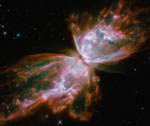 The Hubble Space Telescope is now operational after it’s recent–and last–servicing mission. With its new and improved instruments, the HST is better than ever. On September 9, 2009, Nasa showed off the first batch of images taken with its new camera. The images are nothing less than spectacular! While the equipment may be new, the Hubble team continues the tradition of using their own unique palette to artifically render the various colors of the images which are taken with narrowband filters. Narrowband filters enable astrophotographers to filter out all but select wavelengths of light which are associated with various elements. Doubly ionized oxygen, for example, is at 502nm on the light spectrum and has a bluish color. By using an OIII or 502nm filter, the unique color of this super-heated gas can be imaged.
The Hubble Space Telescope is now operational after it’s recent–and last–servicing mission. With its new and improved instruments, the HST is better than ever. On September 9, 2009, Nasa showed off the first batch of images taken with its new camera. The images are nothing less than spectacular! While the equipment may be new, the Hubble team continues the tradition of using their own unique palette to artifically render the various colors of the images which are taken with narrowband filters. Narrowband filters enable astrophotographers to filter out all but select wavelengths of light which are associated with various elements. Doubly ionized oxygen, for example, is at 502nm on the light spectrum and has a bluish color. By using an OIII or 502nm filter, the unique color of this super-heated gas can be imaged.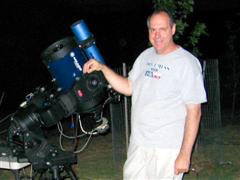 It takes perseverence and passion. Why else, on God’s green earth, would folks like me endure sleep deprivation, hypothermia, insects, and countless technical glitches to sit beside a lumbering telescope for hours and hours? Catching astronomical images requires endless attempts which go on for hours, often after traveling for miles to find a dark site. At times, all the effort pays off. My best evening ever was at a ranch just down the mountain from the McDonald Observatory in Fort Davis, Texas. Clear, dark, dry, calm, and comfortably cool skies prevailed for the evening. I had perfect accommodations with a small lawn on which to set up, just yards away from the porch of our cabin. I spent the evening capturing exposures of the Whirlpool Galaxy (M51), which is one of my all-time favorite astronomical targets. Glorious.
It takes perseverence and passion. Why else, on God’s green earth, would folks like me endure sleep deprivation, hypothermia, insects, and countless technical glitches to sit beside a lumbering telescope for hours and hours? Catching astronomical images requires endless attempts which go on for hours, often after traveling for miles to find a dark site. At times, all the effort pays off. My best evening ever was at a ranch just down the mountain from the McDonald Observatory in Fort Davis, Texas. Clear, dark, dry, calm, and comfortably cool skies prevailed for the evening. I had perfect accommodations with a small lawn on which to set up, just yards away from the porch of our cabin. I spent the evening capturing exposures of the Whirlpool Galaxy (M51), which is one of my all-time favorite astronomical targets. Glorious. Astronomers are an interesting bunch. I’ve never encountered a community so full of polarities. Being the nice guy that I am, let me give you a few pointers, lest you run afoul in your initial forays into this cryptic world.
Astronomers are an interesting bunch. I’ve never encountered a community so full of polarities. Being the nice guy that I am, let me give you a few pointers, lest you run afoul in your initial forays into this cryptic world.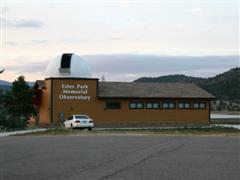 While in Estes Park, Colorado, in July (2009), I had the pleasure of visiting the Estes Park Memorial Observatory. The observatory was founded by Mike and Carole Connolly in memory of their children Thomas and Christian Connolly who died July 2, 2005 in a traffic accident. The surviving daughter of the family, Michele Johnson, is a co-founder with her parents.
While in Estes Park, Colorado, in July (2009), I had the pleasure of visiting the Estes Park Memorial Observatory. The observatory was founded by Mike and Carole Connolly in memory of their children Thomas and Christian Connolly who died July 2, 2005 in a traffic accident. The surviving daughter of the family, Michele Johnson, is a co-founder with her parents.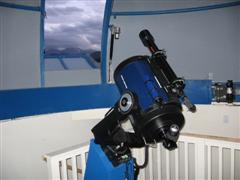 Unfortunately, the sky was overcast, with thunderstorms in the area. What clearing there might have been in the clouds would have been wasted on the lightening. The photo tells the story, with clouds visible through the dome’s aperture. This was our view for all three of the nights I was in town. Also visible in the image is the 16′ interior of the dome and stairway.
Unfortunately, the sky was overcast, with thunderstorms in the area. What clearing there might have been in the clouds would have been wasted on the lightening. The photo tells the story, with clouds visible through the dome’s aperture. This was our view for all three of the nights I was in town. Also visible in the image is the 16′ interior of the dome and stairway.
